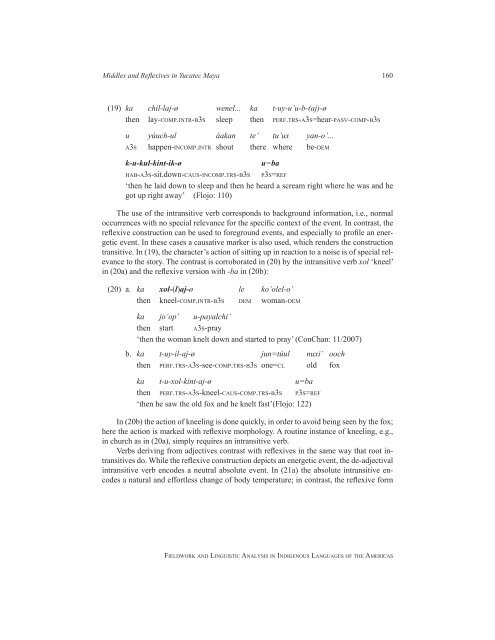Fieldwork and Linguistic Analysis in Indigenous ... - ScholarSpace
Fieldwork and Linguistic Analysis in Indigenous ... - ScholarSpace
Fieldwork and Linguistic Analysis in Indigenous ... - ScholarSpace
You also want an ePaper? Increase the reach of your titles
YUMPU automatically turns print PDFs into web optimized ePapers that Google loves.
Middles <strong>and</strong> Reflexives <strong>in</strong> Yucatec Maya 160<br />
(19) ka chil-laj-ø wenel... ka t-uy-u’u-b-(aj)-ø<br />
then lay-comP.<strong>in</strong>tr-b3s sleep then Perf.trs-a3s=hear-Pasv-comP-b3s<br />
u yúuch-ul áakan te’ tu’ux yan-o’...<br />
a3s happen-<strong>in</strong>comP.<strong>in</strong>tr shout there where be-dem<br />
k-u-kul-k<strong>in</strong>t-ik-ø u=ba<br />
hab-a3s-sit.down-caus-<strong>in</strong>comP.trs-b3s P3s=ref<br />
‘then he laid down to sleep <strong>and</strong> then he heard a scream right where he was <strong>and</strong> he<br />
got up right away’ (Flojo: 110)<br />
The use of the <strong>in</strong>transitive verb corresponds to background <strong>in</strong>formation, i.e., normal<br />
occurrences with no special relevance for the specific context of the event. In contrast, the<br />
reflexive construction can be used to foreground events, <strong>and</strong> especially to profile an energetic<br />
event. In these cases a causative marker is also used, which renders the construction<br />
transitive. In (19), the character’s action of sitt<strong>in</strong>g up <strong>in</strong> reaction to a noise is of special relevance<br />
to the story. The contrast is corroborated <strong>in</strong> (20) by the <strong>in</strong>transitive verb xol ‘kneel’<br />
<strong>in</strong> (20a) <strong>and</strong> the reflexive version with -ba <strong>in</strong> (20b):<br />
(20) a. ka xol-(l)aj-ø le ko’olel-o’<br />
then kneel-comP.<strong>in</strong>tr-b3s dem woman-dem<br />
ka jo’op’ u-payalchi’<br />
then start a3s-pray<br />
‘then the woman knelt down <strong>and</strong> started to pray’ (ConChan: 11/2007)<br />
b. ka t-uy-il-aj-ø jun=túul nuxi’ ooch<br />
then Perf.trs-a3s-see-comP.trs-b3s one=cl old fox<br />
ka t-u-xol-k<strong>in</strong>t-aj-ø u=ba<br />
then Perf.trs-a3s-kneel-caus-comP.trs-b3s P3s=ref<br />
‘then he saw the old fox <strong>and</strong> he knelt fast’ (Flojo: 122)<br />
In (20b) the action of kneel<strong>in</strong>g is done quickly, <strong>in</strong> order to avoid be<strong>in</strong>g seen by the fox;<br />
here the action is marked with reflexive morphology. A rout<strong>in</strong>e <strong>in</strong>stance of kneel<strong>in</strong>g, e.g.,<br />
<strong>in</strong> church as <strong>in</strong> (20a), simply requires an <strong>in</strong>transitive verb.<br />
Verbs deriv<strong>in</strong>g from adjectives contrast with reflexives <strong>in</strong> the same way that root <strong>in</strong>transitives<br />
do. While the reflexive construction depicts an energetic event, the de-adjectival<br />
<strong>in</strong>transitive verb encodes a neutral absolute event. In (21a) the absolute <strong>in</strong>transitive encodes<br />
a natural <strong>and</strong> effortless change of body temperature; <strong>in</strong> contrast, the reflexive form<br />
fieldwork <strong>and</strong> l<strong>in</strong>guistic analysis <strong>in</strong> <strong>in</strong>digenous languages of the americas

















